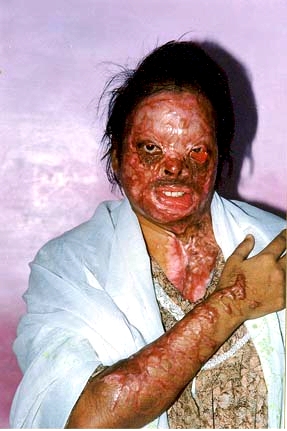Acid Attack or Acid Throwing

When acid is thrown on a person, the results can be horrifying. Nitric, hydrochloric, or sulfuric acids all have a catastrophic effect on human flesh. It causes the skin tissue to melt, often exposing the bones below the flesh, sometimes even dissolving the bone. When acid attacks the eyes, it damages these vital organs permanently. Many acid attack survivors have lost the use of one or both eyes. The victim is traumatized physically, psychologically and socially. (reference)
An acid attack on your body would dramatically change your life. Most survivors of an acid attack are forced to give up their education, their occupation and other important activities in their lives. This is because recovering from the trauma takes up most of their time and because the disfigurement they have to bear debilitates and handicaps them in every conceivable way.
The scars left by acid are not just skin deep, victims are most often faced with
social isolation and ostracisation that further damages their self esteem, self-confidence
and seriously undermines their professional and personal future. Women who have
survived acid attacks have great difficulty in finding work and if unmarried, as
many victims tend to be, they have very little chance of ever getting married, which
in a country like Bangladesh is socially isolating.
Frequency of these attacks
The first documented case of acid violence was in 1967 when a young girl had acid poured on her by her admirer when his proposal of marriage was refused by her mother. So acid violence is a fairly recent phenomenon, at least in Bangladesh. Incidents of acid throwing are also on a rapid rise in Southern Punjab, with over 50 women having suffered from acid burns on their faces or other parts of their bodies in the last six months of 2002.
The situation is no different in other South Asian nations like India and Pakistan. The New York Times (Dec, 26, 2001) reports that kerosene as well as acid has fast become the weapons of choice for attacks on wives in India. The numbers reported above may appear insignificant in the face of more than a billion people that live in South Asia today. But these numbers are only the tip of the iceberg, considering that most incidents go unreported in rural areas. What makes the case of acid throwing more heart wrenching are the grotesque pictures of disfigured women who are now struggling to survive in society. (reference)
It is difficult to obtain accurate statistics because most people in Bangladesh live in rural communities that are relatively isolated and mechanisms to gather information from these communities is weak. But there is evidence to indicate that there is an alarming increase in the number of reported acid attacks incidents in Bangladesh.
In 1996, there were 47 reported cases of acid violence.
In 1997, the number rose to 130.
In 1998, there were over 200 reported cases. It is highly likely that the number of actual cases is considerably higher.
In 1999 the Acid Survivors Foundation started to collect data and in its first year documented 139 known cases. It is highly likely that the number of actual cases is higher.
In 2000 226 cases were documented by the Acid Survivors Foundation.
In 2001, 343 cases were documented.
In 2002 the highest number recorded as 484 which had been lower a little bit in the last year.
In 2003, the number was 410 cases.
Why it happens
The victims are attacked for many reasons. In some cases, the attack takes place because a young girl or woman has spurned the sexual advances of a male or has rejected a proposal of marriage. Recently, however, there have been acid attacks on children, older women and sometimes also men. These attacks are often the result of family or land disputes, dowry demands or a desire for revenge.
Reasons for acid attacks during the years, the highest rate of occurrence took place over Land Disputes and Family dispute, the next highest rate of these brutal incidents are due to refusal of relationship/sex throughout the country.
Who are the victims
The major victim of attacked is Women(47%) and Men(26%). Children(27%) could not escape from the attack. Sometimes domestic animals or birds are also victimized.
(back)
JESSORE, Nov 30, 2005: A man was sentenced to life term imprisonment for throwing acid on his wife by a court here on Nov 22. AKM Zahir, District and Sessions Judge, Jessore while delivering the judgement also fined the accused Shahidul Islam son of late Shamser Ali of village Madhabkati under Kolaroa upazila of Satkhira district Tk one lakh in default to suffer for five years imprisonment.
The court sources said, Shahidul got married with Salma Begum of village Kaiba under Sarsa upazila of Jessore district seven years ago and need to live with his father-in-law’s house. The accused since their wedlock used to torture his wife for dowry but her poor parents were unable to meet the demand. On 17 December 2003, the accused threw acid on his wife causing serious burn injuries on her head, face, breast and waist. (reference)

Connect with us
Contact us today